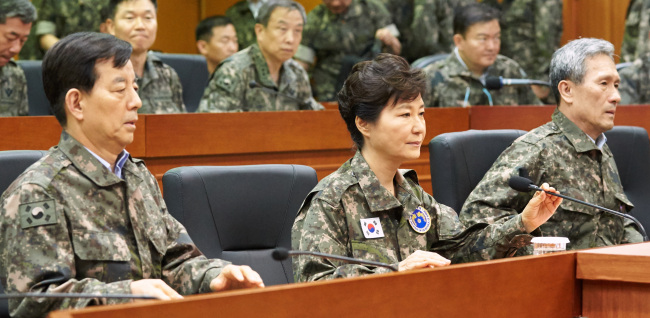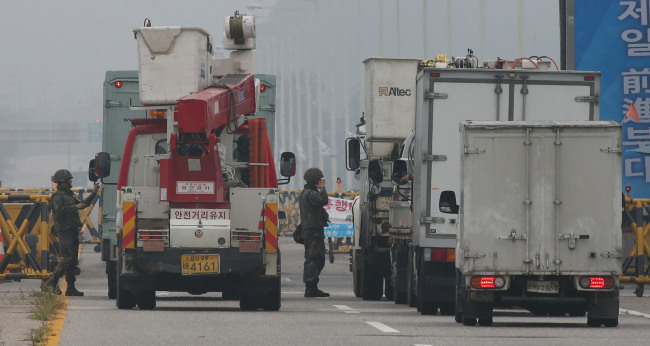Military tensions between the two Koreas rocketed to fresh highs Friday as North Korean leader Kim Jong-un declared a “quasi-state of war” and put frontline troops in full combat readiness, while Seoul continued to snub Pyongyang’s calls for a retraction of loudspeaker broadcasts.
The two sides traded fire Thursday after the North launched artillery shells apparently targeting the loudspeakers installed in the border areas. The communist state then threatened military action unless the South halted the broadcasts and pulled out the equipment by 5 p.m. on Saturday.
The military here remained unwavering in its stance, though it was maintaining maximum readiness posture and bracing for further provocations from across the border.
 |
| President Park Geun-hye, Defense Minister Han Min-koo (left) and National Security Office chief Kim Kwan-jin visit the headquarters of the Third Army in Yongin, Gyeonggi Province, Friday. Cheong Wa Dae |
“As of now, we are continuing and will continue the broadcast program without any change,” a senior official at the Joint Chiefs of Staff told reporters, asking for anonymity due to the sensitivity of the matter.
A Defense Ministry official also said there was no shift in the making, calling the issue a “political” one.
The JCS sent a letter through a West Sea military communication channel to the General Staff of the (North) Korean People’s Army, which had delivered a message the previous day threatening military action if the deadline was not met. The JCS warned that the North’s land mine attack early this month and the latest artillery fire were “illicit, grave provocations that constitute a direct violation” of the armistice and bilateral nonaggression pacts.
“We also urged the North to completely abandon ruthless, rash acts and made clear that we will strongly retaliate in the aspect of self-defense and the North are to bear all the responsibilities resulting from this,” the ministry said in a statement.
Following the exchange of fire, Kim presided over an emergency meeting of the ruling Workers’ Party’s Central Military Commission, instructing frontline units to switch to a “wartime state” and fully arm themselves starting from 5 p.m. on Thursday, state media said.
The North last made the “quasi-state of war” declaration in November 2010 when it shelled a South Korean border island in the West Sea.
“Military commanders were urgently appointed and dispatched for operations to strike the enemy’s means of psychological warfare and quell possible counteraction if it did not stop the propaganda broadcasts,” the official Korean Central Television reported.
President Park Geun-hye urged the South Korean military to stay ready to react immediately to any further provocation and blasted Pyongyang for churning out security threats during her visit to a field army command in Yongin, Gyeonggi Province.
The trip, which came after she shelved her scheduled tour to southern parts of the country, was designed to examine its readiness posture and encourage soldiers, Cheong Wa Dae spokesman Min Kyung-wook said. She was briefed by commanders there on their plans to respond to potential attacks and the current movements by the North Korean military.
Presiding over a video conference with operational commanders later in the day, Defense Minister Han Min-koo also called for airtight readiness and effective situation management, saying that after the deadline the North may stage a provocation “in any way.”
Though Pyongyang did not give any hints, speculation is growing over its possible moves after the deadline, ranging from a long-range missile to short- and midrange artillery to a cyberattack.
 |
| South Korean soldiers inspect vehicles at Tongil Bridge in Paju, Gyeonggi Province, before they cross the Imjin River to head for a joint industrial complex near the inter-Korean border Friday, a day after the rival Koreas traded fire across the Demilitarized Zone. Yonhap |
With no exit strategy in sight on either side, the latest exchange of fire and the increasingly heated rhetoric war rekindled concerns over a potential miscalculation or unintended escalation that may lead to a larger armed clash.
China and Russia, traditional patrons of Pyongyang, called for both sides to refrain and tackle the crisis through dialogue.
“The current situation is dangerous on pen and the risks of miscalculation are much higher than they were a few days ago,” Daniel Pinkston, deputy project director for Northeast Asia at the International Crisis Group, wrote in his analysis.
While stern punishment is key to North Korea’s provocations, South Korea needs to exert abstinence in its responses so as to prevent the battle lines from extending, said Cheong Seong-chang, head of unification strategy research at the Sejong Institute, stressing the need for high-level talks as suggested a day before by chief of the North’s United Front Department in charge of cross-border affairs.
“The regime appears to be making “desperate” efforts to block the broadcasts before they scale up as planned, perturb frontline North Korean troops and thus undermine their morale,” Cheong said.
“With the North harboring a major sense of crisis and anxiety about the broadcasts, it is likely to press ahead with a military provocation if the South continues to air them. A series of tit-for-tat hard-line responses will inevitably inflict huge damage on both sides.”
With the flare-up of tension, the Unification Ministry decided to limit the entry of South Koreans to a joint factory park in the North Korean border city of Gaeseong. Only those in direct charge of business management who could return by the end of the day would be allowed to cross the border until further notice.
As of Friday morning, there were 924 South Koreans counted in North Korea including 830 businesspeople at Gaeseong, 10 historians who are part of a joint archeological excavation team, and 83 youth football players and members of the press in Pyongyang for an international tournament.
By Shin Hyon-hee (heeshin@heraldcorp.com)

